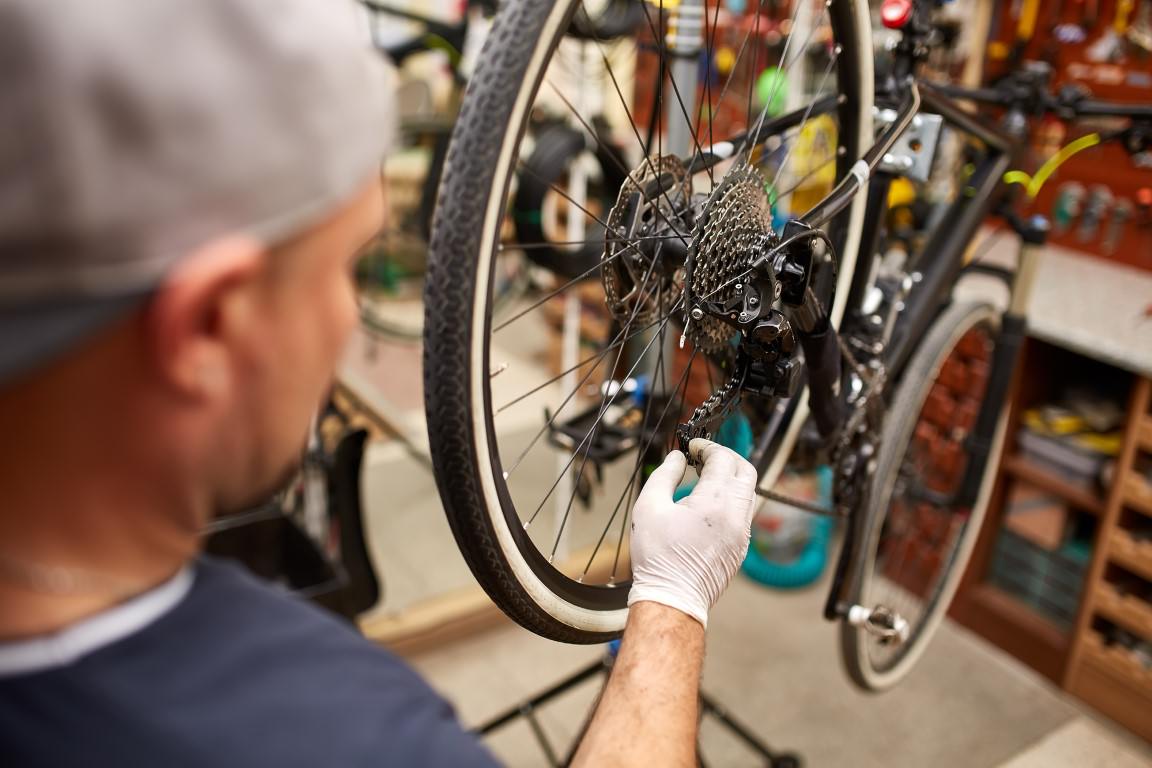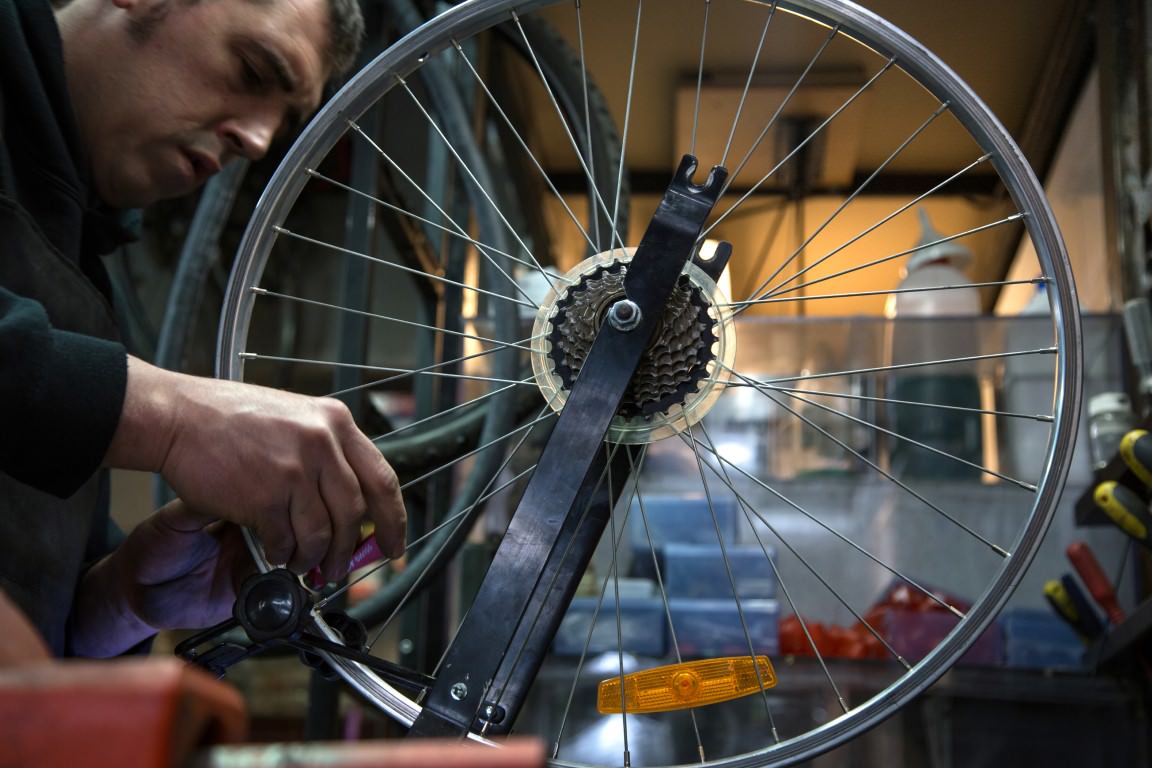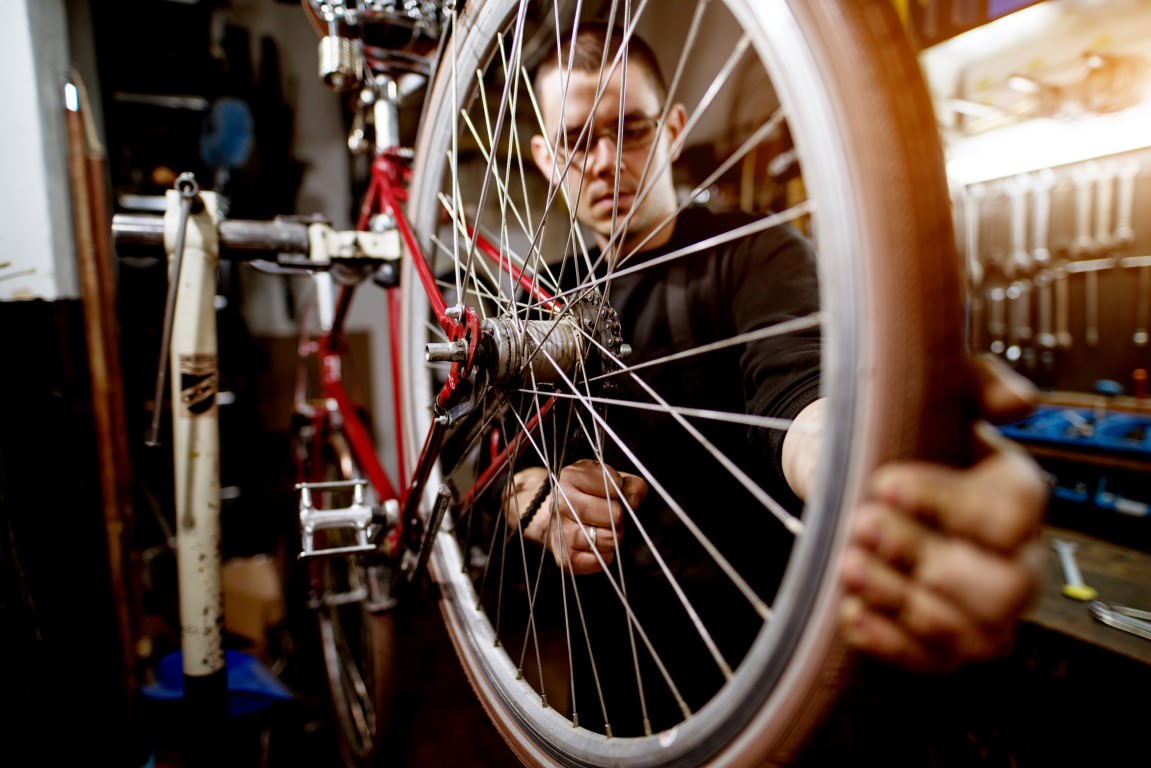Identifying the Problem
There are a few common reasons why your rear bike wheel might be wobbling. To determine the cause and the best course of action for fixing the issue, let’s examine some possible factors:
Wheel Trueness
One possible cause of a wobbly bike wheel is an issue with wheel trueness. Trueness refers to how straight and evenly spaced the wheel’s rim and spokes are. If a wheel isn’t true, it can wobble as it rotates. To check for trueness, observe the wheel while spinning to see if it wobbles from side to side or if there is a noticeable high or low spot:
- Side-to-side wobble: This issue may be caused by uneven spoke tension. You can try tightening or loosening the spokes on either side of the wobble to fix it.
- High or low spot: A bent or dented rim can cause this problem. Straightening the rim by adjusting spoke tension may be possible, but severe damage may require professional help or even a new wheel.
Hub and Bearings Issues
The hub is the central part of the wheel that connects to the bike’s frame and allows it to spin smoothly. If there’s an issue with the hub or its bearings, it can create a wobble in the wheel. Remove the wheel from the bike to inspect the hub and give it a spin. Check for any play or roughness in the rotation:
- Play: If there’s side-to-side movement, the hub may be too loose. To fix this, you will need to adjust the hub’s cone and locknut to achieve the correct tightness.
- Roughness: Damaged or dirty bearings that impede smooth rotation could be the problem. To resolve the issue, you may need to clean, replace, or re-grease the bearings.
Wheel Axle Damage
A damaged axle can also make a wheel wobble. If the axle is bent or broken, it won’t allow the wheel to spin true. To check for axle damage, remove the wheel and examine the axle. You’ll likely need to replace it if it appears bent or damaged. If the wheel doesn’t spin easily on the axle, a problem with the bearings or hub may need to be addressed.

Missing or Misaligned Spokes
Spokes play a critical role in maintaining a wheel’s balance and strength. If a spoke is missing or misaligned, it can lead to a wobbly wheel. Inspect the spokes for any signs of damage:
- Missing spokes: Find a replacement spoke of the correct length and install it as soon as possible to prevent further issues.
- Misaligned spokes: If a spoke is bent or twisted, you can try to straighten it. However, replacing a significantly damaged spoke is often best in order to maintain the wheel’s structural integrity.
Fixing a Wobbling Bike Wheel
Several issues can cause a wobbling bike wheel, such as an uneven rim, bent spokes, worn bearings, or a misaligned axle. To fix a wobbly wheel, it is essential to address these problems individually.
Truing the Wheel
Truing the wheel involves adjusting the spoke tension to correct any side-to-side or up-and-down deviations on the rim. To do this, you’ll need a spoke wrench and a truing stand, or you can use your bike’s frame as a makeshift stand:
- Remove the wheel from the bike and dismantle the tire and tube.
- Mount the wheel on the truing stand or your bike’s frame, making sure it’s centered.
- Spin the wheel slowly, and watch for any wobbles. Identify the area that needs adjustments.
- Use the spoke wrench to tighten or loosen spokes around the problematic area, making small turns until the wobble is corrected.
- Continue checking for wobbles and making adjustments until the wheel is true.
Inspecting and Replacing Bearings
Bearings can wear out or become damaged, causing the wheel to wobble. To check for bad bearings, follow these steps:
- Remove the wheel from the bike.
- Feel for any roughness, grinding, or play in the hub when spinning the axle by hand.
- If any issues are detected, disassemble the hub to inspect the bearings and replace them if necessary.
- Reassemble the hub, ensuring proper bearing preload and hub adjustment.
- Reinstall the wheel on the bike and test for wobble.
Addressing Axle Problems
A bent axle can also cause a wobbly wheel. To determine if your axle is the culprit, remove the wheel from the bike and roll the axle on a flat surface, looking for any bending as it rolls. If the axle is bent, it should be replaced to prevent further damage and ensure a smooth ride.
Amend the Spokes
Spokes can become loose, bent, or broken, causing the wheel to wobble. Inspect the spokes around the wheel for any issues, and perform the following actions:
- Tighten any loose spokes using a spoke wrench.
- Replace bent or broken spokes with the correct size and type for your wheel.
- After making any spoke repairs or replacements, be sure to re-true the wheel as described in the Truing the Wheel section.
Addressing these potential causes of a wobbling bike wheel should help ensure a smoother and safer ride. If the issue persists after taking these steps, consult a professional mechanic for further assistance.

Regular Wheel Maintenance is Crucial
Proper wheel maintenance plays a significant role in preventing rear bike wheel wobbling. It’s essential to regularly inspect and perform maintenance tasks, such as truing the wheel, adjusting bearings, and checking spoke tension. By incorporating these steps into a routine maintenance plan, it’s possible to prevent wobbling and ensure a smoother and safer ride.
One main aspect of wheel maintenance involves truing, which is the process of straightening the wheel by adjusting spoke tension. This can be done with a spoke wrench and a truing stand or by placing the bike upside down and using the brakes as a guide. The goal is to ensure that the wheel’s rim is running in a straight line while it rotates. Truing helps eliminate lateral wobbles and creates a more balanced wheel.
Another essential maintenance task is adjusting the bearings in the rear wheel hub. These bearings ensure the wheel rotates smoothly and freely. Over time, they can become too tight or too loose, causing the wheel to wobble. To adjust these bearings, remove the rear wheel from the bike and use a cone wrench to loosen or tighten the cone, which holds the bearings in place. The correct adjustment will allow the wheel to spin smoothly without any play or wobbling.
Regularly checking spoke tension is also important for wheel stability. Uneven or loose spokes can result in wobbling, as they may not effectively support the wheel’s weight. To check the tension, squeeze pairs of spokes together and assess their tightness by feel. They should feel firm and consistent throughout the wheel. If any spokes are loose, use a spoke wrench to tighten them up, making sure they remain even in tension.
Frequently Asked Questions
Can a wobbling rear bike wheel cause damage to other parts of the bike?
Yes, a wobbling rear bike wheel can cause damage to other parts of the bike. If left unaddressed, it can lead to excessive wear on the tire, chain, and cassette. Additionally, it can put undue stress on the frame, potentially causing cracks or damage over time. It’s essential to fix a wobbling wheel as soon as possible to prevent further issues.
How often should I check the tension of my bike’s spokes?
It’s a good practice to check the tension of your bike’s spokes every few months or every 1,000 miles, whichever comes first. However, if you ride your bike on rough terrain, carry heavy loads, or notice any unusual noises or performance issues, it’s a good idea to check the spoke tension more frequently.
Should I attempt to fix a wobbling bike wheel myself or take it to a professional mechanic?
Whether you should attempt to fix a wobbling bike wheel yourself depends on your experience and comfort level with bike maintenance. If you have the necessary tools and knowledge, you can try fixing minor issues, such as tightening loose spokes or reseating the tire. However, if the problem seems more complex or you’re unsure about the cause, it’s best to consult a professional mechanic to avoid causing further damage or compromising your safety.
Conclusion
Rear bike wheel wobbling can stem from a multitude of factors, such as loose or damaged spokes, an improperly seated tire, or a bent or misaligned wheel. Fortunately, most of these issues can be fixed with a little know-how and the right tools.
Maintaining your bike regularly, addressing problems early on, and knowing when to seek professional assistance are crucial steps in ensuring a safe and enjoyable cycling experience. So, don’t let a wobbly wheel ruin your ride—get back on the saddle and confidently conquer the road!
